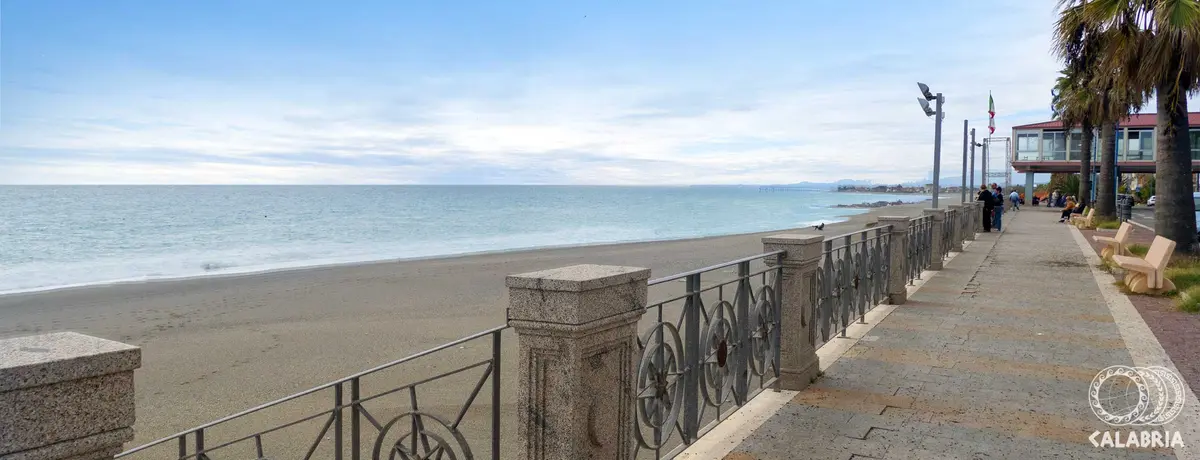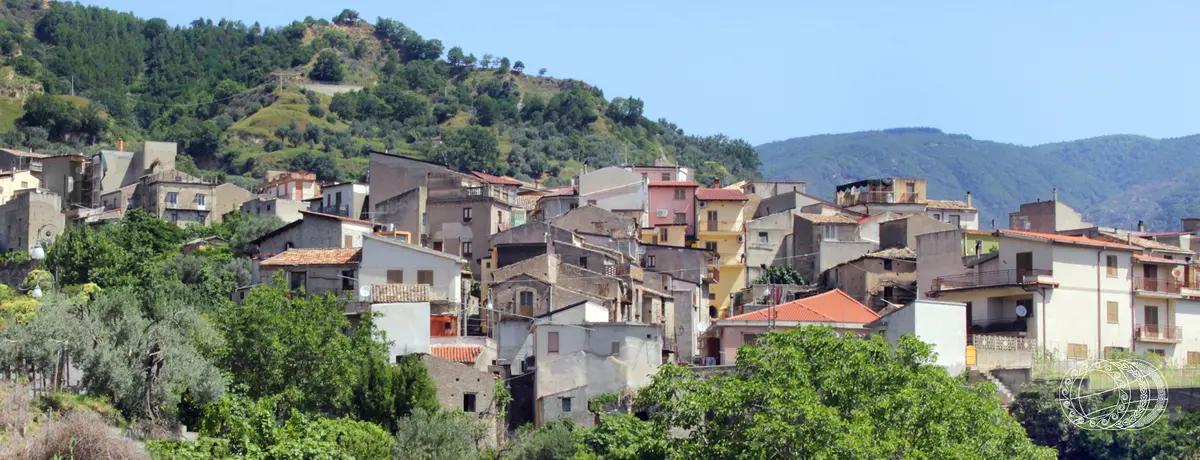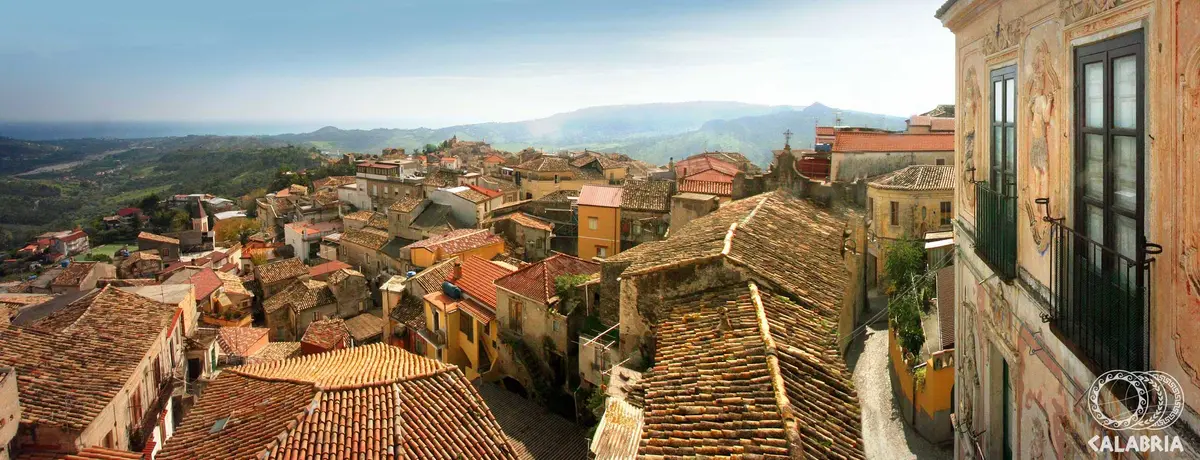Marina di Gioiosa Ionica
Marina di Gioiosa Ionica, theatre of wonderful landscapes

Sea
Marina di Gioiosa Ionica is located near Locri, between Siderno and Roccella, on the Costa dei Gelsomini (Jasmine Coast), the name that identifies the Ionian coast area in the Province of Reggio Calabria.
This is a stretch of sea that has earned the Blue Flag award from 1994 to 2004 and again in 2008 and 2009.
The beach of Marina di Gioiosa Ionica is and bathed by a crystal-clear sea that stretches out in the famous Jasmine Coast, in the heart of Locri.
The waterfront has recently been modernised and equipped with palm trees that give the town a tropical look, but where nature finds its best expression is in the citrus fruits and olive trees that characterise its hilly landscape.
Churches
At the centre of the village stands the church of S. Nicola di Bari, built in 1932 in replacement of the old church of S. Nicola a Mare, demolished due to being damaged by the earthquake of 1908 and by storms. Built in the neoclassical style, inside it has three naves while the raised altar occupies a space of modest size in the apse. The façade has a portal decorated by a large arcade with stucco-work and three stained glass windows depicting respectively a dove, the symbol of the Holy Spirit and the logo of the Great Jubilee in 2000, the image of the Madonna del Carmine and that of the Patron Saint St Nicholas of Bari. Inside, the church preserves work in bronze of the artist Giuseppe Correale, from Siderno; some paintings of excellent workmanship, statues of a certain artistic merit in plaster, in papier-mâché and wood. The Chiesa di San Giuseppe (Church of St Joseph) is located in Camocelli Superiore and was built in an area that combines the beauty of the countryside to cultural demands and those of religious spirituality. The Chiesa della Madonna della Consolazione (Church of Our Lady of Consolation) is located in Junchi, hamlet of Marina di Gioiosa Ionica, at about 5 Km. from the centre and about 200 metres above the sea level.
Greek-Roman theatre
Among the whole ensemble of surviving archaeological monuments in Marina di Gioiosa Ionica, the most important and best known is without a doubt the Roman Theatre, which dates back to the I-II century A.D. The monument's grandeur is unfortunately partially visible, given that a good part of its building materials were used in other buildings, especially to build the adjoining Torre del Cavallaro.
It represents one of the few theatres in the south of Italy and its stable character brings it closer to the Greek world, seen that Roman theatres were constructed in wood. The Hellenic style, together with the fact that it is the last of the theatres built in Calabria during the classical period, justifies the fame of this work with scholars of the sector. Due to its peculiar shape and unusual structure, the building refers to a period of transition between Greek and Roman theatrical architecture. Greek reminiscences are found in the cavea, formed by a perfect hemicycle, of which only nine orders of seats remain. Worthy of mention is the proscenium that displays two small staircases connecting the orchestra, used in antiquity to access the Choir. In recent decades, the Greek-Roman theatre of Marina di Gioiosa Ionica has relived the glories of the past, serving as a stage at important musical and theatrical events, with big names of the Italian entertainment world. In this theatre there are two side entrances or “parodos” (this is also a Greek element) that gave access to the orchestra, through two vestibules surmounted by arches in masonry. Of these, after the collapse of the vaults, only fragments remain, supported by supports, recently fitted by restorers. Originally the cavea was probably constituted by 20 half- circles and1200 seats. In the excavation campaign followed the discovery of the structure, two terracotta pots were discovered in the side niches, while in the left cavea an earthenware amphora was found with the opening looking toward the orchestra.
Cavallaro Tower
n the past, Torre del Cavallaro was known as Torre Borraca or Torre di Spina. The name is due to the fact that two vigilants on horseback, indeed the "cavallari", had to signal the possible approaching of barbaric gangs. Officially, the tower is regarded as a fortress of the XVI century, but according to some scholars its foundation goes back in fact to the Byzantine age, and is due to the work of a Greek strategist, General Nikephoros II Phokas, which in order to curb the outburst of Saracen hordes implemented a system of Coastal Towers along Calabria’s coast. The tower, of a cylindrical shape, tapered at its upper half, is made of ordinary masonry in lime and stones, in its construction incorporates material coming from the adjacent Greek-Roman theatre. The lower part of the building is set on a talus, while the upper one, leaner, is provided with monumental relics; the two parts of the building are mutually separated by a stone moulding, with a round groove located at the height of the right half of the small fortress. Up in the crowning, merlons surrounded modillions, as shelves, as can be seen by the few advances that exist in the north-east side. Probably, the Tower was visual connected with similar defensive outposts of nearby coastal towns, such as the Torre dei Tamburi in Siderno, Torre Pizzofalcone of Rocca di Rupella and Torre di Camillari in Caulonia.
Galea Tower
Torre Galea, in reality, should be called castello (castle) and is made up by a triptych of very high towers with bases on an escarpment, two of which with a circular floor-plan, then cylindrical and the third with a square floor-plan, provided with a drawbridge precisely in accordance with the traditional pattern of Castles. The Tower is situated in the surroundings of the town of Marina di Gioiosa Ionica; a short distance from the Torre del Cavallaro, heading toward the old fief of Galea. The shape of the monument is unique in the entire region and is somewhat similar to the architectural blueprint of the Aragonese Castle of Gioiosa Ionica, and therefore, this has allowed to establish its historical role.
Over the course of time the building has undergone major renovations and was also the subject of restoration works by the Superintendence. Recently, the Tower was acquired by the architectural heritage of the town of Marina di Gioiosa Ionica.
Useful information
What to know about Marina di Gioiosa Ionica
Events
There are 1 events scheduled.
Where to Sleep
There are 7 available accommodations.
Places
There are 2 places to visit.
Travel Ideas
There are 2 travel ideas.
Infopoint Gioiosa Ionica
Gioiosa Ionica
No result








